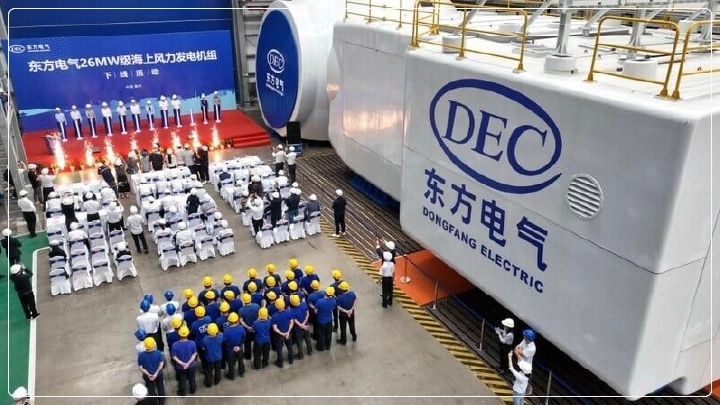China Sets New Global Benchmark with Record-Breaking 26-Megawatt Wind Turbine
China's Dongfang Electric Corporation has presented a new benchmark of capacity and size with a 26-megawatt offshore wind turbine. The turbine, with a rotor diameter exceeding 310 meters and at an elevation of 185 meters, can generate 100 gigawatt-hours annually under optimal wind conditions, enough to power around 55,000 homes and achieve tremendous carbon reductions.

Of course, no one can argue with the leadership position of China in renewable energy; the sales and investments in renewable energy posted an all-time high of 13.6 trillion yuan ($1.9 trillion) in 2024. The total installed renewable energy capacity of the country, including wind and solar, is beyond that of coal in capacity, totaling 1,410 gigawatts. Oven and beyond, China's dominance sits with 95% of polysilicon and wafer production worldwide and operates nearly 50% of the world's offshore wind installed capacity.
The Significance of the 26-MW Wind Turbine
China is building a record turbine to show the offshore wind sector's potential. Offshore wind farms have higher energy production potential because of stronger wind speeds, prevention problem of land acquisition, and carbon emission benefits. A Dongfang 26-MW turbine will save around 30,000 tons of coal use and 80,000 tons of carbon dioxide a year.
China’s Wind Energy Impact on the Asia-Pacific Region
The resulting repercussions of progress in offshore wind technology for China would be very significant for the rest of the Asia-Pacific region. Countries also like Japan, South Korea, and Taiwan with the glut of technological advancements China has made upon the offshore front in slow motion toward some resolution. Larger and more efficient turbines are driving down costs per megawatt hour. This merits a greater assertion of competitiveness for wind energy. The Southeast Asian countries including Vietnam and the Philippines are eyeing offshore wind projects in partnership with Chinese companies, entering into development through large-scale wind energy infrastructure installations drawn by China's Belt and Road Initiative. The increasing growth of the wind turbine manufacturing sector in China will offer opportunities to local suppliers while benefiting established shipbuilding and heavy manufacturing industries.
Global Offshore Wind Trends and U.S. Challenges
Offshore wind energy in the US is facing hurdles during Trump's second presidency, an executive order freezing wind energy approvals, stopping the offshore wind lease sales, and demanding a review of all projects previously approved. All these cause concern among renewable energy advocates since wind energy accounts for 10% of U.S. electricity generation. The suspension of projects would lead to increased electricity costs and less expedited clean energy adoption. The Gulf of Mexico wind auction in 2023 recorded a disappointing award-winning of $5.6 million, flagging resistance in the traditional oil and gas bastions. Nevertheless, the authority believes that the Gulf has the potential to turn into a significant offshore wind hub due to the most established energy generation infrastructure along with green hydrogen production potential.
China's Active Role in the International Offshore Wind Property
China is the largest generator of offshore wind energy in the world and exports wind turbine technology, develops joint ventures with foreign energy companies, and commits towards carbon neutrality in 2060. A major impact has been caused on the global offshore wind markets through the deployment of 26-MW offshore wind turbines. The qualifications and stipulations of policies hovering on uncertain terrains in the US wind energy sector juxtapose these two superpowers. The rapid development in offshore wind technology therefore enhances energy security and propels the world towards a cleaner and sustainable energy future.